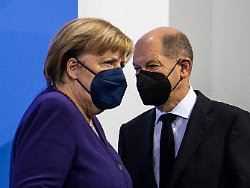Wednesday, December 8th, 2021
Bundestag, Steinmeier, Merkel
This is how Scholz’s election for chancellor works
For the first time since 2005, the SPD is again appointing the Federal Chancellor: In the morning, the traffic light parties want to elect Olaf Scholz as the new head of government. His ministers also take over their offices during the day.
Germany’s first traffic light coalition in the federal government starts: the SPD, the Greens and the FDP want to elect the Social Democrat Olaf Scholz as the ninth Chancellor of the Federal Republic of Germany in the Bundestag in the morning. He must receive at least 369 votes in the vote – the three traffic light parties together have 416 seats. According to the Basic Law, the vote takes place without prior debate.
The 63-year-old would be the fourth SPD chancellor after Willy Brandt, Helmut Schmidt and Gerhard Schröder. The CDU has so far provided the four chancellors Konrad Adenauer, Ludwig Erhard, Kurt Georg Kiesinger and Helmut Kohl and, for the past 16 years, Chancellor Angela Merkel.
Handover of the Chancellery in the afternoon
After the vote in the Bundestag, Federal President Frank-Walter Steinmeier handed Scholz the certificate of appointment at around 10.15 a.m. This means that government power is transferred to the new Chancellor. At 12 noon, Scholz will be sworn in by President Bärbel Bas in the Bundestag. At the suggestion of Scholz, Steinmeier then appoints the federal ministers.
In the afternoon, the previous Chancellor Angela Merkel hands over the Chancellery to her successor. Most of the new ministers will also be welcomed to their offices during the afternoon to hand over their duties.
7x SPD, 5x green, 4x FDP
The SPD had won the federal election on September 26th and, after catching up, was the strongest force with 25.7 percent, ahead of the CDU / CSU (24.1 percent). In purely mathematical terms, with this result the Union could also have led a Jamaica alliance with the Greens and the FDP. However, the two smaller parties opted for coalition negotiations with the SPD.
The SPD has seven ministers in the new government: Wolfgang Schmidt (Head of the Chancellery), Karl Lauterbach (Health), Hubertus Heil (Labor and Social Affairs), Nancy Faeser (Inside), Christine Lambrecht (Defense), Klara Geywitz (Construction) and Svenja Schulze (development).
For the Greens, Annalena Baerbock (outside), Robert Habeck (economy and climate protection), Anne Spiegel (family), Steffi Lemke (environment) and Cem Özdemir (agriculture) move into the cabinet. Habeck is also Vice Chancellor. The cabinet members of the FDP are Christian Lindner (finance), Volker Wissing (transport), Marco Buschmann (justice) and Bettina Stark-Watzinger (education).
